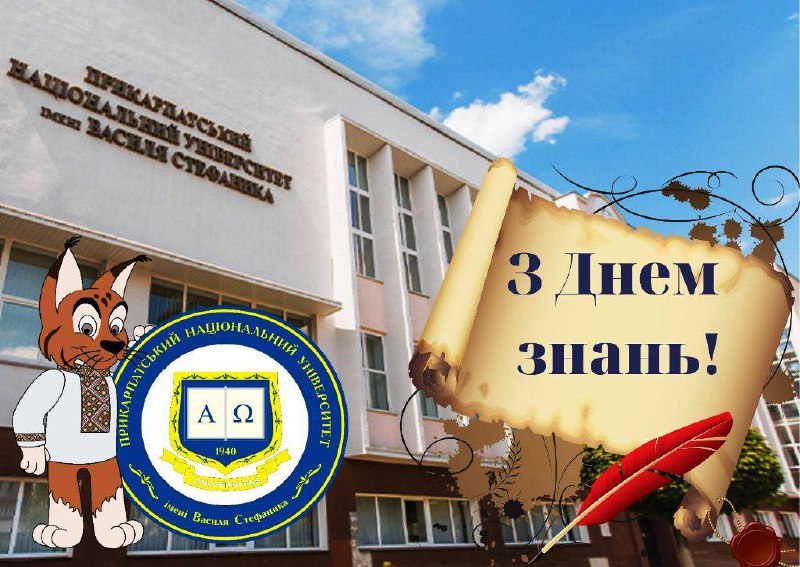Congratulations to teachers and students on the start of the new 2023-2024 academic year! Peace, victory to us all!
A unique lexicographic project has been completed – the publication of the supplement “Onymic Vocabulary” to the two-volume dictionary “Hutsul Dialect Lexicon and Phrasemics in the Ukrainian Artistic Language”, the authors of which are scientists of Vasyl Stefanyk Prykarpattia National University: Professor Vasyl Hreshchuk and Associate Professor, Director of the Educational and Scientific Institute of Ukrainian Studies Valentina Greschuk. It is significant that it was published on the eve of the Day of Knowledge, because the first volume was released before the Day of Ukrainian writing and language in 2019, and the second volume – on the eve of the Day of the Mother Language in 2020.
A specific problem for the dictionary “Hutsul Dialect Vocabulary and Phrasemics in the Ukrainian Artistic Language” is the proper vocabulary used in artistic texts on Hutsul subjects. Proper names, by their very nature, are not dialectics in the conventional sense. It is characteristic that the subject of dialectological studies is usually appellative vocabulary, while dialect dictionaries do not provide onomic vocabulary, although some linguists emphasize the need for a special study of dialectological aspects of onomastic vocabulary. Thus, I.I. Kovalik, reflecting on whether all toponymic names belong to the general lexical composition, which of them can be attributed to the main vocabulary, noted: “We think that the names of large cities and the year of a certain country can be attributed to the main vocabulary fund of the national language of this nation. Well-known local toponymic names of a certain district can probably be attributed to the main vocabulary of this dialect.” Therefore, the scientist considered it necessary to consider the onymic lexicon as an important component of the national lexicon, at the same time to distinguish between universal and local, regional proper names.
The connection of the proper vocabulary with dialect lexemes is obvious. Firstly, dialectal names are the basis of many onims, secondly, the onomasticon of different regions is characterized by certain features corresponding to dialectal oppositions in the area of appellative vocabulary. This is well illustrated by separate word-forming types of onymic vocabulary, which are characterized by territorial localization.
In literary texts on Hutsul topics, in which lexical dialectics are used, there are many different proper names, some of which are expressive markers of Hutsul, as well as Hutsul dialect words. Such proper names are common in the Hutsul region. Some of them (Hoverla, Prut, Kosiv, Dovbush, Chugaister) are known not only in Hutsul Oblast, but also far beyond its borders, the functioning of others is limited to the range of Hutsul Oblast, its parts, or neighboring territories adjacent to it, however, both are directly related to the Hutsul lexicon, are its integral components.
Another important issue is related to the completeness of the Dictionary’s coverage of onymic vocabulary used in artistic texts, on the basis of which the Dictionary’s lexical card index is compiled. Among the proper names available in the index, the majority are Hutsul-marked words, they are identifiers of the Hutsul Region, but there are many that are indifferent to it and only indirectly related to the Hutsul world, for example: Kozak, Didushenko, Podlyaskyi, Lviv, Chernivtsi, Brody, Drohobych, Danube, etc. Such and similar proper names are also elaborated in the Dictionary, as they represent the relationships of the Hutsul region with other regions of Ukraine, with the Slavic region and the rest of the world.
The lexicographically elaborated proprietary vocabulary in the dictionary contains valuable information that significantly enriches the linguistic picture of the Hutsul world with knowledge about the complete mastery of the toponymy of the Hutsul region by Ukrainian fiction in their relationships with the toponyms of various ethnographic regions and ethnic groups, other onymic vocabulary in its functional, evaluative, and emotional expressive images. Thus, oikonyms, the frequency of their use in the artistic language testify to the importance and priority of certain settlements in the life of the highlanders, they record the defining centers of the historical-political, economic, religious, cultural and artistic spheres of the Hutsuls.
Anthroponyms, in addition to revealing the peculiarities and specifics of the Hutsul naming of persons, record the connection of the Highlanders with representatives of other peoples, primarily of neighboring former or present states – Poles, Czechs, Romanians, Moldovans, Germans, Jews.
Oronyms used in literary texts on the Hutsul theme testify, on the one hand, to the difficult landscape conditions of life and management of the Hutsuls, which influenced the formation of their character, outlook and worldview, and, on the other hand, represent an exceptional love for their mountainous region, fascination with its beauty and uniqueness.
The nature of this unique region is organically complemented by wayward rivers, rapid streams, and high mountain lakes. Cheremosh and Prut – the names of the two largest Hutsul rivers, whose sources are at the foot of Hoverla and Chornohora – are the most common in literary texts about Hutsuls. And also many names of smaller rivers and streams, names of mysterious mountains

